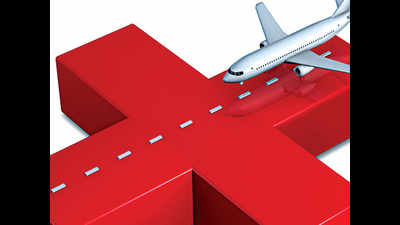- News
- City News
- mumbai News
- 2017 reverse flight: International passengers soar twice as fast as domestic at Mumbai's airport
Trending
This story is from January 18, 2018
2017 reverse flight: International passengers soar twice as fast as domestic at Mumbai's airport

(Representative image)
NEW DELHI: In a complete reversal of trend, the number of international flyers is now growing more than twice as fast as domestic ones at Mumbai’s constrained Chhatrapati Shivaji International Airport (CSIA). In the calendar year 2017, international flyers at the airport grew 9.1% while domestic grew at 4.4% over 2016. The picture was different in 2016, when domestic flyers grew at 12% and international at 5% over 2015.
The reason for the reversal is that the GVK-run airport does not have any free slots during the day and other hours when airlines desperately want to add domestic flights to and from the megapolis. “We had a few slots at night which suited international flights and were given to them,” said an airport official.
This led to international travel growing faster than domestic in Mumbai. India, as a whole, saw its domestic air travel growing at almost double the pace of its international traffic. Delhi IGI Airport, India’s busiest, also saw domestic travel growing faster than international in 2017 over 2016.
The infrastructure-starved CSIA handles about 940 flights a day and is the world’s busiest single-runway airport. With its cross runways handling the maximum possible flights, there is no scope to add any more during most hours. As a result, its overall traffic growth was limited to just 5.6% — way below the rate at which Delhi and overall traffic in India is growing.
“International growth was more than domestic primarily because of some capacity available at night to early morning period,” CAPA-Centre for Aviation India head Kapil Kaul said. “CSIA continues to improve runway productivity significantly, which allowed the expansion (in
An official of a Mumbai-based travel major said some new international flights were added in Mumbai last year.
“Rwanda Air, Garuda, Brussels Airlines, Thai Smile and Air Canada were among those who started flights last year. On domestic side, I cannot recall any significant addition in flights. Airlines like Air Deccan wanted slots for regional flights under the government’s subsidised UDAN scheme but could not be given,” the official said.
Mumbai’s air connectivity will improve only after the Navi Mumbai airport, also being developed by the GVK Group, gets operational in five to six years.
The reason for the reversal is that the GVK-run airport does not have any free slots during the day and other hours when airlines desperately want to add domestic flights to and from the megapolis. “We had a few slots at night which suited international flights and were given to them,” said an airport official.
This led to international travel growing faster than domestic in Mumbai. India, as a whole, saw its domestic air travel growing at almost double the pace of its international traffic. Delhi IGI Airport, India’s busiest, also saw domestic travel growing faster than international in 2017 over 2016.
The infrastructure-starved CSIA handles about 940 flights a day and is the world’s busiest single-runway airport. With its cross runways handling the maximum possible flights, there is no scope to add any more during most hours. As a result, its overall traffic growth was limited to just 5.6% — way below the rate at which Delhi and overall traffic in India is growing.
Mumbai airport’s overall traffic was 4.46 crore in 2016, up 10% from 4.06 crore in 2015. The overall growth lowered in 2017 due to the airport approaching peak capacity.
“International growth was more than domestic primarily because of some capacity available at night to early morning period,” CAPA-Centre for Aviation India head Kapil Kaul said. “CSIA continues to improve runway productivity significantly, which allowed the expansion (in
flight handling) despite very significant constraints.”
An official of a Mumbai-based travel major said some new international flights were added in Mumbai last year.
“Rwanda Air, Garuda, Brussels Airlines, Thai Smile and Air Canada were among those who started flights last year. On domestic side, I cannot recall any significant addition in flights. Airlines like Air Deccan wanted slots for regional flights under the government’s subsidised UDAN scheme but could not be given,” the official said.
Mumbai’s air connectivity will improve only after the Navi Mumbai airport, also being developed by the GVK Group, gets operational in five to six years.
End of Article
FOLLOW US ON SOCIAL MEDIA










